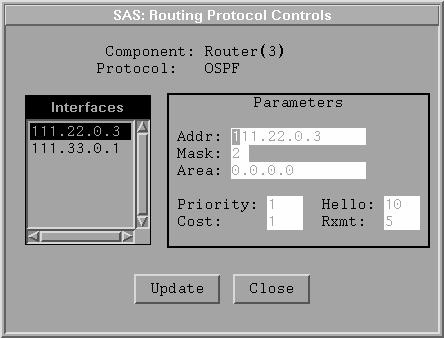Chapter Contents
Previous
Next
|
Chapter Contents |
Previous |
Next |
| Protocols |
OSPF also divides the network into areas; however, OSPF has a special area (Area 0) called the OSPF backbone. The backbone distributes routing information between non-backbone areas. Unlike the IS-IS protocol, a router can be part of two or more different areas in OSPF. These routers are called area border routers, and their functionality is similar to the Level 2 routers in IS-IS. An area border router runs a separate copy of the basic OSPF algorithm for each area to which it belongs. A sample OSPF topology is depicted in Figure A.9.

As in IS-IS, OSPF routers periodically transmit hello packets and keep an internal database with information from all neighbor hellos they receive. When a router gets a hello packet from another router, a Designated Router (DR) is elected (if they are on the same LAN) and an attempt is made to form what is called an adjacency. For two routers to become fully adjacent, they must first establish two-way communication between them and synchronize their link state databases. Adjacencies can be established only when one of the routers is the DR or BDR or when the connection between the routers is a point-to-point link.
Each router periodically floods link information packets called link state advertizements (LSAs) out its interfaces. Every router originates a router-LSA for every area it is in, and these LSAs propagate throughout the entire area. If the router is the DR for a LAN, it also originates a network-LSA describing all the routers connected to the LAN. A network-LSA is also propagated throughout the respective area. Area border routers generate summary-LSAs for each of their areas that describe the destinations reachable in those areas. These LSAs are then transmitted into other areas to disseminate the information throughout the network.
When a router receives an LSA, it incorporates the information into its link state database and, if necessary, floods the LSA out specific interfaces so the information can reach other routers as well. Routers use the information in their link state databases to calculate their routing table, again using the Dijkstra algorithm. A router ages and periodically purges outdated information in its link state database and then rebuilds its routing table insuring that only current link state information is used for forwarding packets.
The current implementation of OSPF in netWorks does not support inter-area routing, and therefore you cannot model multiple area autonomous systems.
Unlike IS-IS routers, each interface of a router running OSPF has configurable parameters as opposed to one set of parameters for the entire router. The OSPF parameters that you can modify on a per interface basis are displayed in Figure A.10.

|
Chapter Contents |
Previous |
Next |
Top |
Copyright © 1999 by SAS Institute Inc., Cary, NC, USA. All rights reserved.